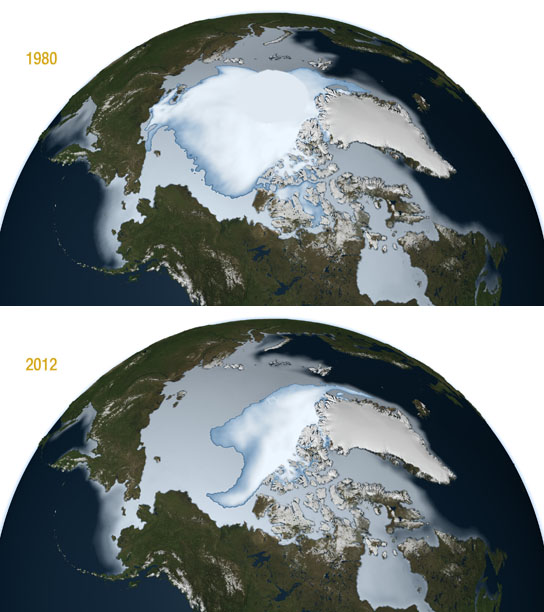
These photos illustrate how perennial sea ice has declined from 1980 to 2012. The bright white central mass shows the perennial sea ice while the larger light blue area shows the full extent of the winter sea ice including the average annual sea ice during the months of November, December and January. The data shown here were compiled by NASA senior research scientist Josefino Comiso from NASA’s Nimbus-7 satellite and the U.S. Department of Defense’s Defense Meteorological Satellite Program. Credit: NASA/Goddard Scientific Visualization Studio.
Research complied from NASA’s Nimbus-7 satellite and the U.S. Department of Defense’s Defense Meteorological Satellite Program by senior research scientist Josefino Comiso shows how multi-year ice, ice that has made it through at least two summers, has diminished with each passing winter over the last three decades.
A new NASA study revealed that the oldest and thickest Arctic sea ice is disappearing at a faster rate than the younger and thinner ice at the edges of the Arctic Ocean’s floating ice cap.
The thicker ice, known as multi-year ice, survives through the cyclical summer melt season, when young ice that has formed over winter just as quickly melts again. The rapid disappearance of older ice makes Arctic sea ice even more vulnerable to further decline in the summer, said Joey Comiso, senior scientist at NASA Goddard Space Flight Center, Greenbelt, Maryland, and author of the study, which was recently published in the Journal of Climate.
The new research takes a closer look at how multi-year ice, ice that has made it through at least two summers, has diminished with each passing winter over the last three decades. Multi-year ice “extent” – which includes all areas of the Arctic Ocean where multi-year ice covers at least 15 percent of the ocean surface – is diminishing at a rate of -15.1 percent per decade, the study found.
There’s another measurement that allows researchers to analyze how the ice cap evolves: multi-year ice “area,” which discards areas of open water among ice floes and focuses exclusively on the regions of the Arctic Ocean that are completely covered by multi-year ice. Sea ice area is always smaller than sea ice extent, and it gives scientists the information needed to estimate the total volume of ice in the Arctic Ocean. Comiso found that multi-year ice area is shrinking even faster than multi-year ice extent, by -17.2 percent per decade.
“The average thickness of the Arctic sea ice cover is declining because it is rapidly losing its thick component, the multi-year ice. At the same time, the surface temperature in the Arctic is going up, which results in a shorter ice-forming season,” Comiso said. “It would take a persistent cold spell for most multi-year sea ice and other ice types to grow thick enough in the winter to survive the summer melt season and reverse the trend.”
Scientists differentiate multi-year ice from both seasonal ice, which comes and goes each year, and “perennial” ice, defined as all ice that has survived at least one summer. In other words: all multi-year ice is perennial ice, but not all perennial ice is multi-year ice (it can also be second-year ice).
Comiso found that perennial ice extent is shrinking at a rate of -12.2 percent per decade, while its area is declining at a rate of -13.5 percent per decade. These numbers indicate that the thickest ice, multi-year ice, is declining faster than the other perennial ice that surrounds it.
As perennial ice retreated in the last three decades, it opened up new areas of the Arctic Ocean that could then be covered by seasonal ice in the winter. A larger volume of younger ice meant that a larger portion of it made it through the summer and was available to form second-year ice. This is likely the reason why the perennial ice cover, which includes second year ice, is not declining as rapidly as the multi-year ice cover, Comiso said.
Multi-year sea ice hit its record minimum extent in the winter of 2008. That is when it was reduced to about 55 percent of its average extent since the late 1970s, when satellite measurements of the ice cap began. Multi-year sea ice then recovered slightly in the three following years, ultimately reaching an extent 34 percent larger than in 2008, but it dipped again in winter of 2012, to its second lowest extent ever.
For this study, Comiso created a time series of multi-year ice using 32 years of passive microwave data from NASA’s Nimbus-7 satellite and the U.S. Department of Defense’s Defense Meteorological Satellite Program, taken during the winter months from 1978 to 2011. This is the most robust and longest satellite dataset of Arctic sea ice extent data to date, Comiso said.
Younger ice, made from recently frozen ocean waters, is saltier than multi-year ice, which has had more time to drain its salts. The salt content in first- and second-year ice gives them different electrical properties than multi-year ice: In winter, when the surface of the sea ice is cold and dry, the microwave emissivity of multiyear ice is distinctly different from that of first- and second-year ice. Microwave radiometers on satellites pick up these differences in emissivity, which are observed as variations in brightness temperature for the different types of ice. The “brightness” data are used in an algorithm to discriminate multi-year ice from other types of ice.
Comiso compared the evolution of the extent and area of multi-year ice over time, and confirmed that its decline has accelerated during the last decade, in part because of the dramatic decreases of 2008 and 2012. He also detected a periodic nine-year cycle, where sea ice extent would first grow for a few years, and then shrink until the cycle started again. This cycle is reminiscent of one occurring on the opposite pole, known as the Antarctic Circumpolar Wave, which has been related to the El Niño-Southern Oscillation atmospheric pattern. If the nine-year Arctic cycle were to be confirmed, it might explain the slight recovery of the sea ice cover in the three years after it hit its historical minimum in 2008, Comiso said.
Reference: “Large Decadal Decline of the Arctic Multiyear Ice Cover” by Josefino C. Comiso, 15 February 2012, Journal of Climate.
DOI: 10.1175/JCLI-D-11-00113.1









Global warming is mainly caused by us humans putting heat of some man made kind into the upper atmosphere where nature needs a certain temperature to maintain an environment it has been able to maintain for millions of years before us humans started putting hot air into the upper atmosphere. There is one major thing that we humans do that is putting massive amounts of hot air into the upper atmosphere and that is the flying of jet engine airplanes and weapons and rockets of all kinds These devices have heat ranges from 800 degrees to 2500 degrees or more. The Space Shuttle was as hot as the Sun! The upper atmosphere use to be about 32 degrees. All this man made heat we put up into the upper atmosphere has raised the temperatures in the upper atmosphere. Plus these jet engine airplanes are also gigantic vacuum machines that are sucking up the moisture molecules, which are cloud producing molecules, in the upper atmosphere which means less clouds and rain. Less clouds causes more of the Sun’s rays to reach Earth which causes more heating of our planet. Also jet engine airplanes add many numerous pollutants to the upper atmosphere that makes it harder for nature to produce clouds! WE CAN END GLOBAL WARMING IMMEDIATELY if we ALL would stop flying jet engine airplanes and go back to flying propeller airplanes which don’t heat up or pollute the upper atmosphere like jet engine airplanes. We had 2 world wars using propeller airplanes and didn’t have global warming problems. In about 1960 the world started using jet engine airplanes and since then the world has seen an increase in global warming every year since the 1960’s! Check out flightradar24.com to see that every day there is about 90,000 jet flights worldwide and that doesn’t include military jets. EVERY DAY we humans are putting up at the minimum 194,400,000 enclosed super size football stadiums of hot air from jet planes into the upper atmosphere! And this figure doesn’t even include the military jet planes and rockets of all kinds! To end global warming immediately we have to stop flying jet engine airplanes and stop driving combustion engine vehicles and start driving electric cars. If we don’t then in about 10-15 years the North and South poles as well as most ice glaciers will have mostly melted and the the Earth will be on a path to total destruction as the environment of the Earth changes into an unlivable planet as the Sun bakes the earth into a dead planet as the Sun did the same to Venus and Mars, planets that also lost it’s livable atmosphere. Read my Facebook page of Ron McCune from Chicago, Illinois for more details.
Is it possible to use speed rail roads such as Elon Musk is developing on continents and connect continents using propeller planes. Example train to Alaska, propeller planes to cross to Siberia and pick up Musk trains to Europe?